University of Hail: NURS 513 Article Review on Exercise Study
VerifiedAdded on 2022/08/29
|6
|1472
|24
Report
AI Summary
This report presents a critical review of the article "Exercise participation decisions of Jordanian myocardial infarction patients: application of the decisional conflict theory" by Al-Hassana and Wierenga (2000). The review assesses the study's title, introduction, literature review, methodology (including sampling, ethical considerations, and study design), data analysis, and findings. The reviewer evaluates the strengths and limitations of the research, highlighting the clarity of the title and introduction while critiquing the literature review's depth and the sampling method's potential for bias. The analysis examines the study's cross-sectional design, data analysis techniques, and the conclusions drawn regarding the correlation between exercise and decisional conflict-related stress. The review concludes by discussing the implications of the study for nursing practice, acknowledging the limitations that may affect the generalizability of the findings due to the study's design and sampling method. References are provided to support the analysis.
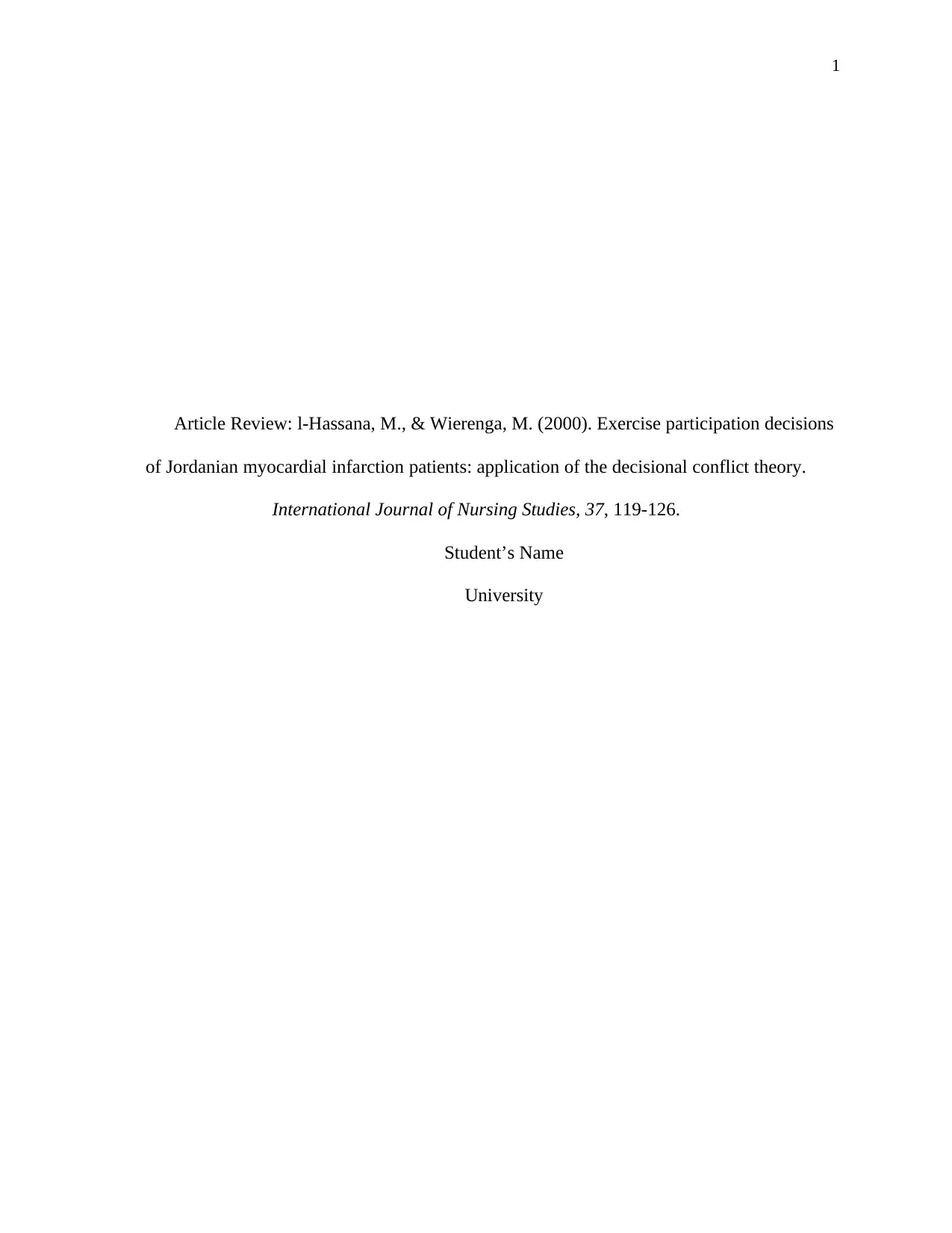
1
Article Review: l-Hassana, M., & Wierenga, M. (2000). Exercise participation decisions
of Jordanian myocardial infarction patients: application of the decisional conflict theory.
International Journal of Nursing Studies, 37, 119-126.
Student’s Name
University
Article Review: l-Hassana, M., & Wierenga, M. (2000). Exercise participation decisions
of Jordanian myocardial infarction patients: application of the decisional conflict theory.
International Journal of Nursing Studies, 37, 119-126.
Student’s Name
University
Paraphrase This Document
Need a fresh take? Get an instant paraphrase of this document with our AI Paraphraser
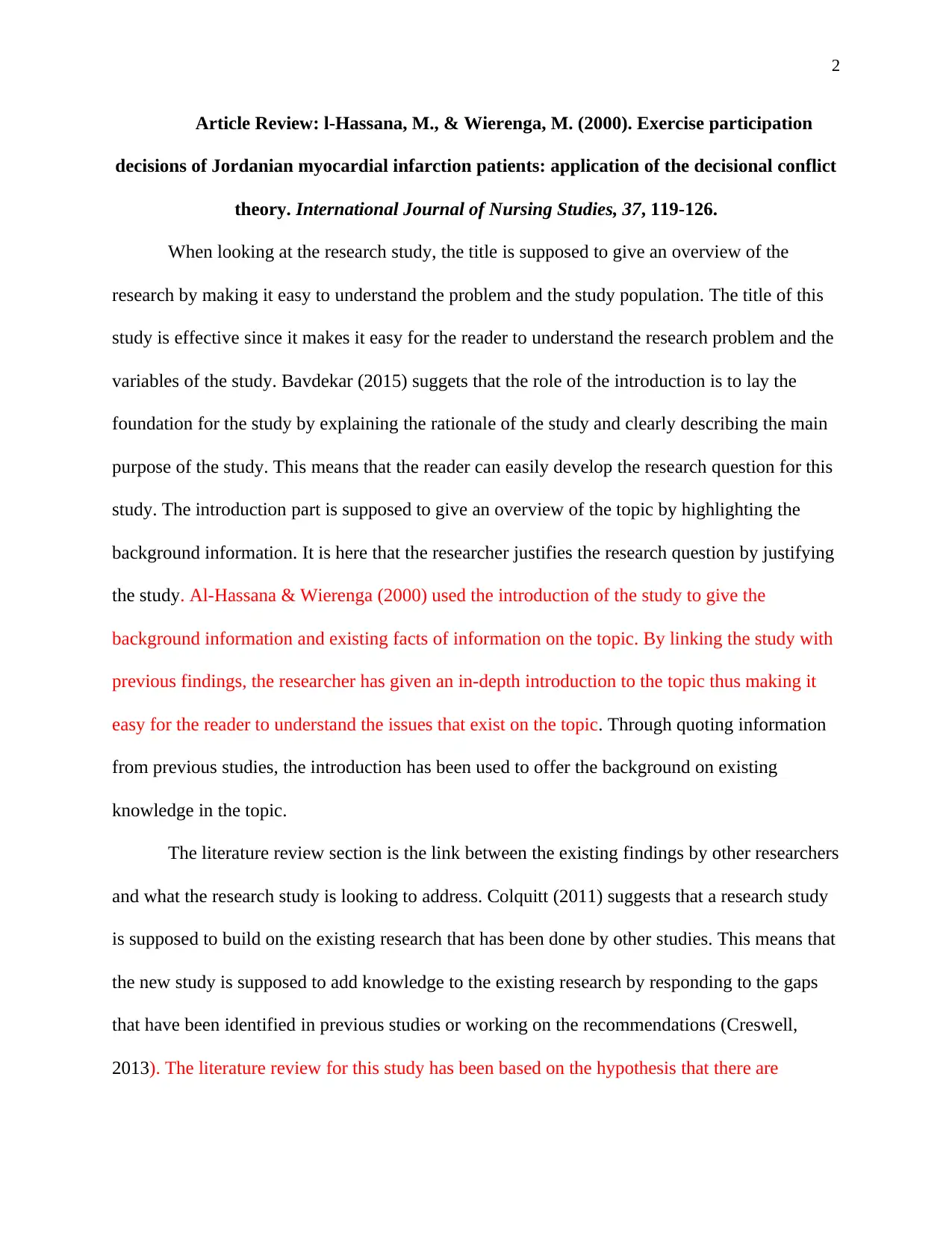
2
Article Review: l-Hassana, M., & Wierenga, M. (2000). Exercise participation
decisions of Jordanian myocardial infarction patients: application of the decisional conflict
theory. International Journal of Nursing Studies, 37, 119-126.
When looking at the research study, the title is supposed to give an overview of the
research by making it easy to understand the problem and the study population. The title of this
study is effective since it makes it easy for the reader to understand the research problem and the
variables of the study. Bavdekar (2015) suggets that the role of the introduction is to lay the
foundation for the study by explaining the rationale of the study and clearly describing the main
purpose of the study. This means that the reader can easily develop the research question for this
study. The introduction part is supposed to give an overview of the topic by highlighting the
background information. It is here that the researcher justifies the research question by justifying
the study. Al-Hassana & Wierenga (2000) used the introduction of the study to give the
background information and existing facts of information on the topic. By linking the study with
previous findings, the researcher has given an in-depth introduction to the topic thus making it
easy for the reader to understand the issues that exist on the topic. Through quoting information
from previous studies, the introduction has been used to offer the background on existing
knowledge in the topic.
The literature review section is the link between the existing findings by other researchers
and what the research study is looking to address. Colquitt (2011) suggests that a research study
is supposed to build on the existing research that has been done by other studies. This means that
the new study is supposed to add knowledge to the existing research by responding to the gaps
that have been identified in previous studies or working on the recommendations (Creswell,
2013). The literature review for this study has been based on the hypothesis that there are
Article Review: l-Hassana, M., & Wierenga, M. (2000). Exercise participation
decisions of Jordanian myocardial infarction patients: application of the decisional conflict
theory. International Journal of Nursing Studies, 37, 119-126.
When looking at the research study, the title is supposed to give an overview of the
research by making it easy to understand the problem and the study population. The title of this
study is effective since it makes it easy for the reader to understand the research problem and the
variables of the study. Bavdekar (2015) suggets that the role of the introduction is to lay the
foundation for the study by explaining the rationale of the study and clearly describing the main
purpose of the study. This means that the reader can easily develop the research question for this
study. The introduction part is supposed to give an overview of the topic by highlighting the
background information. It is here that the researcher justifies the research question by justifying
the study. Al-Hassana & Wierenga (2000) used the introduction of the study to give the
background information and existing facts of information on the topic. By linking the study with
previous findings, the researcher has given an in-depth introduction to the topic thus making it
easy for the reader to understand the issues that exist on the topic. Through quoting information
from previous studies, the introduction has been used to offer the background on existing
knowledge in the topic.
The literature review section is the link between the existing findings by other researchers
and what the research study is looking to address. Colquitt (2011) suggests that a research study
is supposed to build on the existing research that has been done by other studies. This means that
the new study is supposed to add knowledge to the existing research by responding to the gaps
that have been identified in previous studies or working on the recommendations (Creswell,
2013). The literature review for this study has been based on the hypothesis that there are
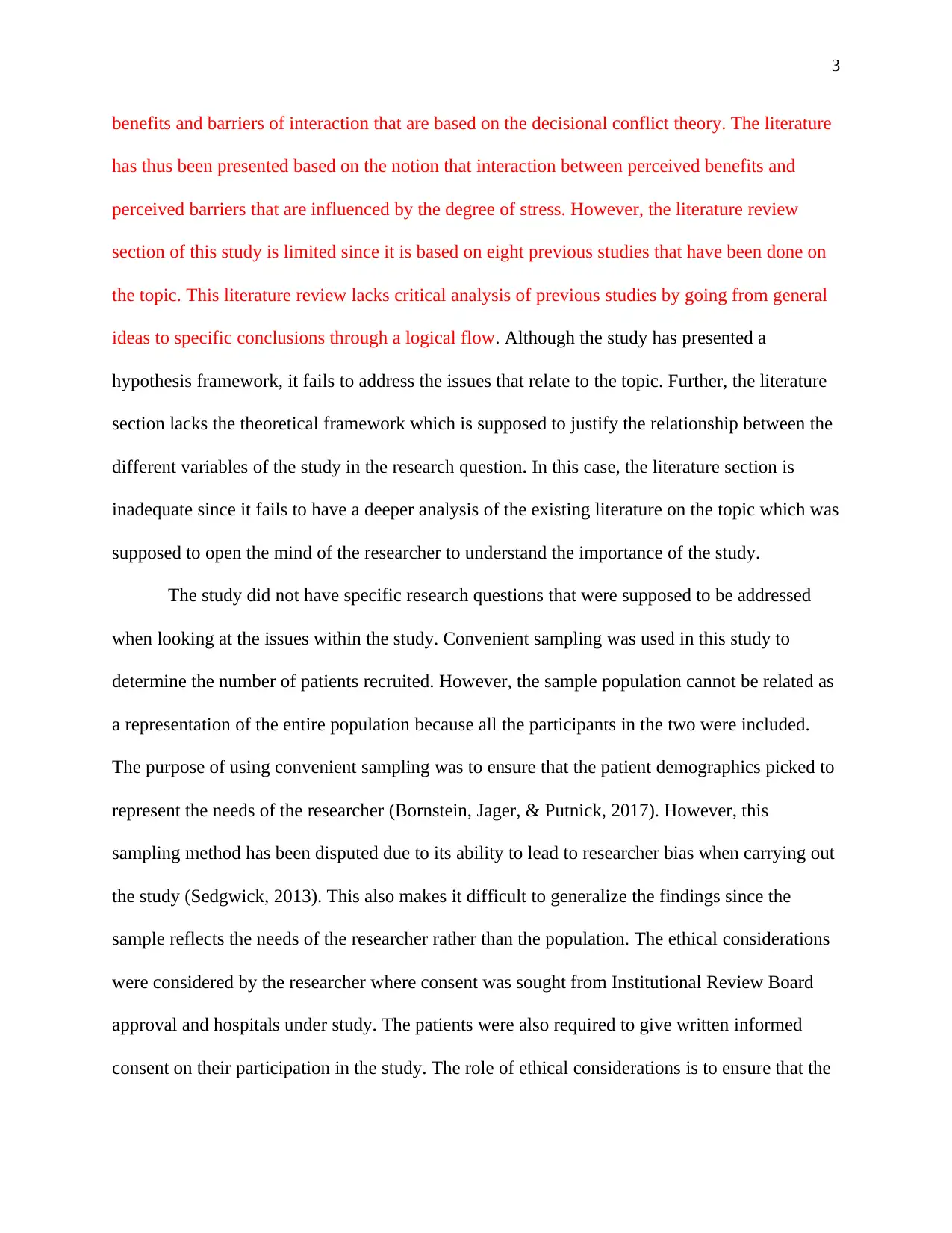
3
benefits and barriers of interaction that are based on the decisional conflict theory. The literature
has thus been presented based on the notion that interaction between perceived benefits and
perceived barriers that are influenced by the degree of stress. However, the literature review
section of this study is limited since it is based on eight previous studies that have been done on
the topic. This literature review lacks critical analysis of previous studies by going from general
ideas to specific conclusions through a logical flow. Although the study has presented a
hypothesis framework, it fails to address the issues that relate to the topic. Further, the literature
section lacks the theoretical framework which is supposed to justify the relationship between the
different variables of the study in the research question. In this case, the literature section is
inadequate since it fails to have a deeper analysis of the existing literature on the topic which was
supposed to open the mind of the researcher to understand the importance of the study.
The study did not have specific research questions that were supposed to be addressed
when looking at the issues within the study. Convenient sampling was used in this study to
determine the number of patients recruited. However, the sample population cannot be related as
a representation of the entire population because all the participants in the two were included.
The purpose of using convenient sampling was to ensure that the patient demographics picked to
represent the needs of the researcher (Bornstein, Jager, & Putnick, 2017). However, this
sampling method has been disputed due to its ability to lead to researcher bias when carrying out
the study (Sedgwick, 2013). This also makes it difficult to generalize the findings since the
sample reflects the needs of the researcher rather than the population. The ethical considerations
were considered by the researcher where consent was sought from Institutional Review Board
approval and hospitals under study. The patients were also required to give written informed
consent on their participation in the study. The role of ethical considerations is to ensure that the
benefits and barriers of interaction that are based on the decisional conflict theory. The literature
has thus been presented based on the notion that interaction between perceived benefits and
perceived barriers that are influenced by the degree of stress. However, the literature review
section of this study is limited since it is based on eight previous studies that have been done on
the topic. This literature review lacks critical analysis of previous studies by going from general
ideas to specific conclusions through a logical flow. Although the study has presented a
hypothesis framework, it fails to address the issues that relate to the topic. Further, the literature
section lacks the theoretical framework which is supposed to justify the relationship between the
different variables of the study in the research question. In this case, the literature section is
inadequate since it fails to have a deeper analysis of the existing literature on the topic which was
supposed to open the mind of the researcher to understand the importance of the study.
The study did not have specific research questions that were supposed to be addressed
when looking at the issues within the study. Convenient sampling was used in this study to
determine the number of patients recruited. However, the sample population cannot be related as
a representation of the entire population because all the participants in the two were included.
The purpose of using convenient sampling was to ensure that the patient demographics picked to
represent the needs of the researcher (Bornstein, Jager, & Putnick, 2017). However, this
sampling method has been disputed due to its ability to lead to researcher bias when carrying out
the study (Sedgwick, 2013). This also makes it difficult to generalize the findings since the
sample reflects the needs of the researcher rather than the population. The ethical considerations
were considered by the researcher where consent was sought from Institutional Review Board
approval and hospitals under study. The patients were also required to give written informed
consent on their participation in the study. The role of ethical considerations is to ensure that the
⊘ This is a preview!⊘
Do you want full access?
Subscribe today to unlock all pages.

Trusted by 1+ million students worldwide
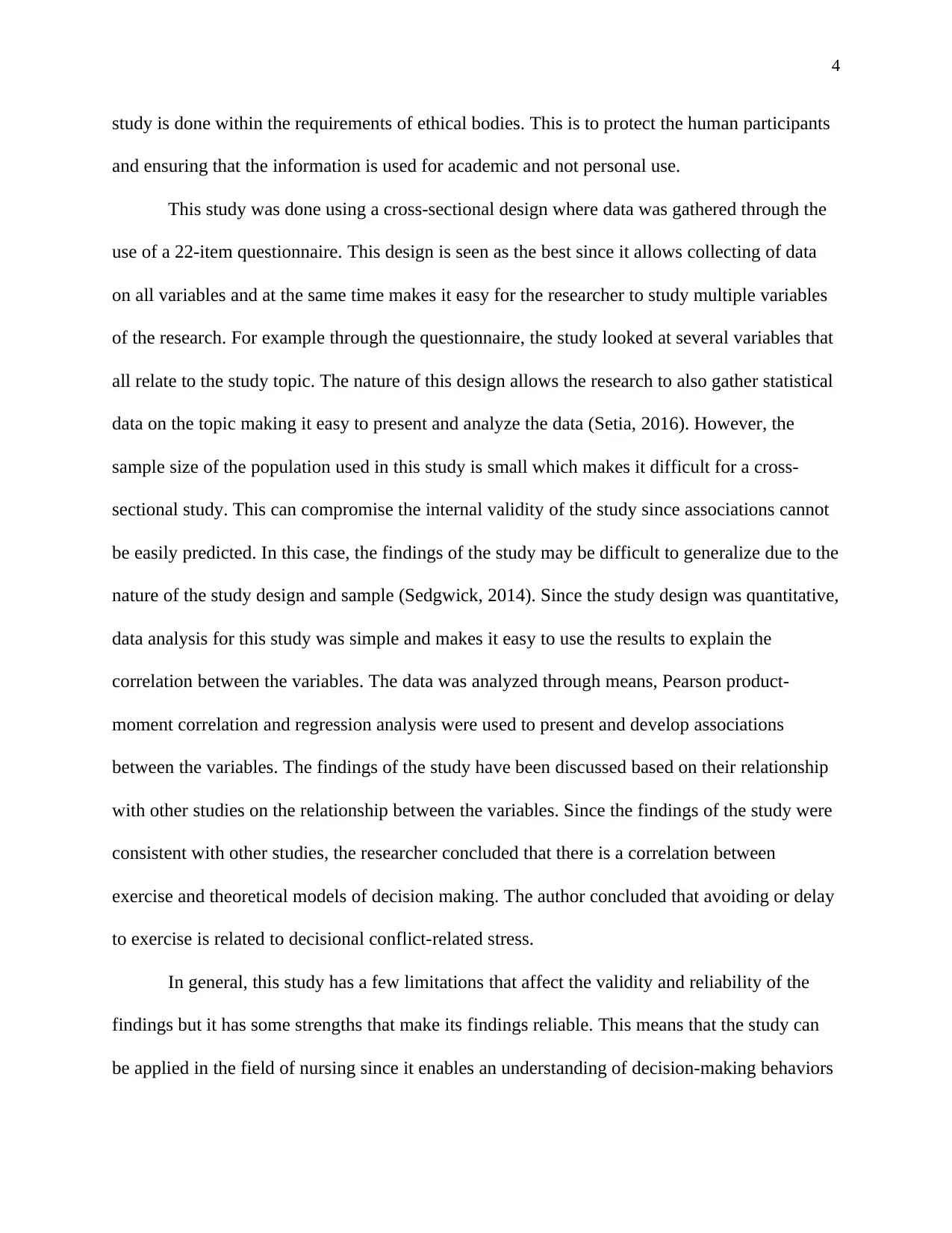
4
study is done within the requirements of ethical bodies. This is to protect the human participants
and ensuring that the information is used for academic and not personal use.
This study was done using a cross-sectional design where data was gathered through the
use of a 22-item questionnaire. This design is seen as the best since it allows collecting of data
on all variables and at the same time makes it easy for the researcher to study multiple variables
of the research. For example through the questionnaire, the study looked at several variables that
all relate to the study topic. The nature of this design allows the research to also gather statistical
data on the topic making it easy to present and analyze the data (Setia, 2016). However, the
sample size of the population used in this study is small which makes it difficult for a cross-
sectional study. This can compromise the internal validity of the study since associations cannot
be easily predicted. In this case, the findings of the study may be difficult to generalize due to the
nature of the study design and sample (Sedgwick, 2014). Since the study design was quantitative,
data analysis for this study was simple and makes it easy to use the results to explain the
correlation between the variables. The data was analyzed through means, Pearson product-
moment correlation and regression analysis were used to present and develop associations
between the variables. The findings of the study have been discussed based on their relationship
with other studies on the relationship between the variables. Since the findings of the study were
consistent with other studies, the researcher concluded that there is a correlation between
exercise and theoretical models of decision making. The author concluded that avoiding or delay
to exercise is related to decisional conflict-related stress.
In general, this study has a few limitations that affect the validity and reliability of the
findings but it has some strengths that make its findings reliable. This means that the study can
be applied in the field of nursing since it enables an understanding of decision-making behaviors
study is done within the requirements of ethical bodies. This is to protect the human participants
and ensuring that the information is used for academic and not personal use.
This study was done using a cross-sectional design where data was gathered through the
use of a 22-item questionnaire. This design is seen as the best since it allows collecting of data
on all variables and at the same time makes it easy for the researcher to study multiple variables
of the research. For example through the questionnaire, the study looked at several variables that
all relate to the study topic. The nature of this design allows the research to also gather statistical
data on the topic making it easy to present and analyze the data (Setia, 2016). However, the
sample size of the population used in this study is small which makes it difficult for a cross-
sectional study. This can compromise the internal validity of the study since associations cannot
be easily predicted. In this case, the findings of the study may be difficult to generalize due to the
nature of the study design and sample (Sedgwick, 2014). Since the study design was quantitative,
data analysis for this study was simple and makes it easy to use the results to explain the
correlation between the variables. The data was analyzed through means, Pearson product-
moment correlation and regression analysis were used to present and develop associations
between the variables. The findings of the study have been discussed based on their relationship
with other studies on the relationship between the variables. Since the findings of the study were
consistent with other studies, the researcher concluded that there is a correlation between
exercise and theoretical models of decision making. The author concluded that avoiding or delay
to exercise is related to decisional conflict-related stress.
In general, this study has a few limitations that affect the validity and reliability of the
findings but it has some strengths that make its findings reliable. This means that the study can
be applied in the field of nursing since it enables an understanding of decision-making behaviors
Paraphrase This Document
Need a fresh take? Get an instant paraphrase of this document with our AI Paraphraser

5
within patient populations. Therefore, the implications of this stud can be applied in the practice
of nursing but its limitations make it difficult to generalize the findings to the whole population.
This is due to the nature of the study design and sampling method which affect its reliability.
within patient populations. Therefore, the implications of this stud can be applied in the practice
of nursing but its limitations make it difficult to generalize the findings to the whole population.
This is due to the nature of the study design and sampling method which affect its reliability.
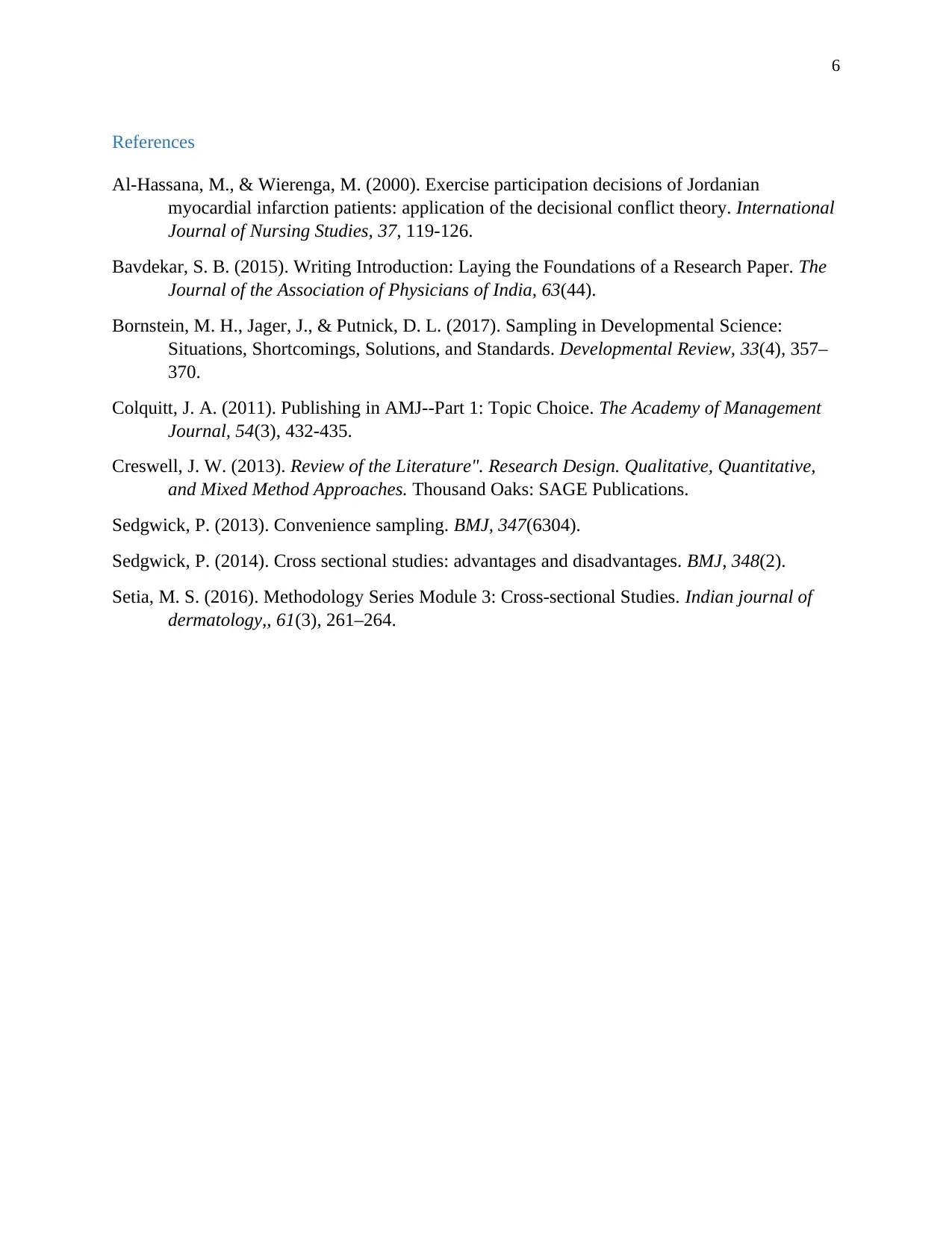
6
References
Al-Hassana, M., & Wierenga, M. (2000). Exercise participation decisions of Jordanian
myocardial infarction patients: application of the decisional conflict theory. International
Journal of Nursing Studies, 37, 119-126.
Bavdekar, S. B. (2015). Writing Introduction: Laying the Foundations of a Research Paper. The
Journal of the Association of Physicians of India, 63(44).
Bornstein, M. H., Jager, J., & Putnick, D. L. (2017). Sampling in Developmental Science:
Situations, Shortcomings, Solutions, and Standards. Developmental Review, 33(4), 357–
370.
Colquitt, J. A. (2011). Publishing in AMJ--Part 1: Topic Choice. The Academy of Management
Journal, 54(3), 432-435.
Creswell, J. W. (2013). Review of the Literature". Research Design. Qualitative, Quantitative,
and Mixed Method Approaches. Thousand Oaks: SAGE Publications.
Sedgwick, P. (2013). Convenience sampling. BMJ, 347(6304).
Sedgwick, P. (2014). Cross sectional studies: advantages and disadvantages. BMJ, 348(2).
Setia, M. S. (2016). Methodology Series Module 3: Cross-sectional Studies. Indian journal of
dermatology,, 61(3), 261–264.
References
Al-Hassana, M., & Wierenga, M. (2000). Exercise participation decisions of Jordanian
myocardial infarction patients: application of the decisional conflict theory. International
Journal of Nursing Studies, 37, 119-126.
Bavdekar, S. B. (2015). Writing Introduction: Laying the Foundations of a Research Paper. The
Journal of the Association of Physicians of India, 63(44).
Bornstein, M. H., Jager, J., & Putnick, D. L. (2017). Sampling in Developmental Science:
Situations, Shortcomings, Solutions, and Standards. Developmental Review, 33(4), 357–
370.
Colquitt, J. A. (2011). Publishing in AMJ--Part 1: Topic Choice. The Academy of Management
Journal, 54(3), 432-435.
Creswell, J. W. (2013). Review of the Literature". Research Design. Qualitative, Quantitative,
and Mixed Method Approaches. Thousand Oaks: SAGE Publications.
Sedgwick, P. (2013). Convenience sampling. BMJ, 347(6304).
Sedgwick, P. (2014). Cross sectional studies: advantages and disadvantages. BMJ, 348(2).
Setia, M. S. (2016). Methodology Series Module 3: Cross-sectional Studies. Indian journal of
dermatology,, 61(3), 261–264.
⊘ This is a preview!⊘
Do you want full access?
Subscribe today to unlock all pages.

Trusted by 1+ million students worldwide
1 out of 6
Related Documents
Your All-in-One AI-Powered Toolkit for Academic Success.
+13062052269
info@desklib.com
Available 24*7 on WhatsApp / Email
![[object Object]](/_next/static/media/star-bottom.7253800d.svg)
Unlock your academic potential
Copyright © 2020–2025 A2Z Services. All Rights Reserved. Developed and managed by ZUCOL.





